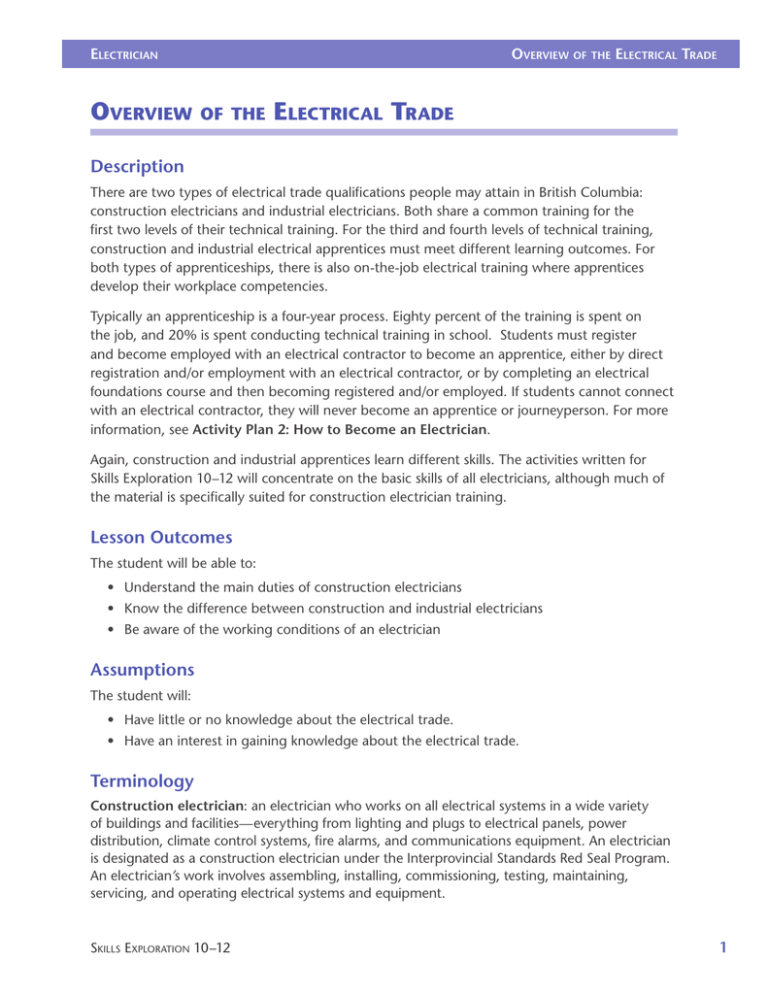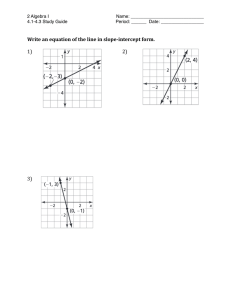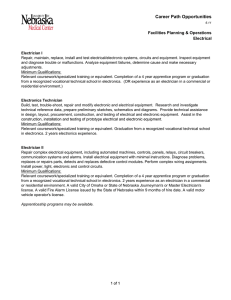Overview Of the electrical trade
advertisement

Electrician Overview Overview of the Electrical Trade of the Electrical Trade Description There are two types of electrical trade qualifications people may attain in British Columbia: construction electricians and industrial electricians. Both share a common training for the first two levels of their technical training. For the third and fourth levels of technical training, construction and industrial electrical apprentices must meet different learning outcomes. For both types of apprenticeships, there is also on-the-job electrical training where apprentices develop their workplace competencies. Typically an apprenticeship is a four-year process. Eighty percent of the training is spent on the job, and 20% is spent conducting technical training in school. Students must register and become employed with an electrical contractor to become an apprentice, either by direct registration and/or employment with an electrical contractor, or by completing an electrical foundations course and then becoming registered and/or employed. If students cannot connect with an electrical contractor, they will never become an apprentice or journeyperson. For more information, see Activity Plan 2: How to Become an Electrician. Again, construction and industrial apprentices learn different skills. The activities written for Skills Exploration 10–12 will concentrate on the basic skills of all electricians, although much of the material is specifically suited for construction electrician training. Lesson Outcomes The student will be able to: • Understand the main duties of construction electricians • Know the difference between construction and industrial electricians • Be aware of the working conditions of an electrician Assumptions The student will: • Have little or no knowledge about the electrical trade. • Have an interest in gaining knowledge about the electrical trade. Terminology Construction electrician: an electrician who works on all electrical systems in a wide variety of buildings and facilities—everything from lighting and plugs to electrical panels, power distribution, climate control systems, fire alarms, and communications equipment. An electrician is designated as a construction electrician under the Interprovincial Standards Red Seal Program. An electrician’s work involves assembling, installing, commissioning, testing, maintaining, servicing, and operating electrical systems and equipment. Skills Exploration 10–12 1 Overview of the Electrical Trade Electrician Electrical contractor: an employer or sponsor of electrical apprentices who provides workbased training for electrical apprentices. An electrical contractor is a business person or firm that performs specialized construction work related to the design, installation, and maintenance of electrical systems. Essential skills: foundation skills such as reading, math, and document use. Essential Skills were created by the Industry Training Authority (ITA) to help people prepare for success in the first two levels of technical training during their apprenticeship. Each trade requires Essential Skills, but to different degrees. For example, both carpenters and bakers use math, but electricians need trigonometry and bakers do not. Industrial electrician: an electrician who is typically employed on staff, working at operational large-scale industrial facilities such as pulp mills, hydroelectric dams, and mining and smelting operations maintaining and modifying functioning systems and facilities. Industry Training Authority (ITA): the organization responsible for leading and coordinating the skilled trades training and credentialing system for the province of BC. ITA provides strategic leadership, policy support, and customer services to help apprentices, employers, and industry. ITA sets program standards, maintains credential records, and issues the highly regarded Interprovincial Red Seal (IP) and BC Certificate of Qualification (CofQ) credentials. Interprovincial Red Seal and BC Certificate of Qualification: Through the Red Seal Program, certified tradespeople can obtain a “Red Seal” endorsement on their BC Certificates of Qualification. The Red Seal allows qualified tradespeople to practise their trade in any province or territory in Canada where the trade is designated, without having to write further examinations. See www.red-seal.ca for additional information on the Red Seal Program. The Certificate of Qualification is only recognized in the province where it is obtained. National Occupational Classification (NOC): a standardized description of the work performed by Canadians in the labour market. It gives statisticians, labour market analysts, career counsellors, employers, and individual job seekers a consistent way to collect data and describe and understand the nature of work. Technical training: training for the electrical trade that is conducted in school. Working conditions: the conditions in which an individual works, including environment, noise levels, degree of safety, physical environment, wages, and hours of work. Estimated Time 1–4 hours Recommended Number of Students 20, based on BC Technology Educators’ Best Practice Guide Facilities Classroom or computer lab 2 Skills Exploration 10–12 Electrician Overview of the Electrical Trade Tools Projector with computer and speakers, Internet access Materials none Recommended Introducing this activity plan would be a great opportunity to invite an electrical contractor in as a guest speaker to talk about the electrical trade. The person could speak to the students about duties performed by an electrician and working conditions. The speaker could also share experiential stories about the trade as well as their experiences as an apprentice. Resources Skills Canada 2008—Electrical Wiring Keewatin Career Development Corporation (KCDC) video. Each skill competition video demonstrates a trade in action, performed during the Skills Canada Competition 2008 in Calgary. http://www.youtube.com/watch?v=WjwrTAPJ2IY BCIT construction electrician video http://cdl-prod.bcit.ca/ltc/download/media/apprenticeship/electrical_full.wmv Industrial Electrician—Working in Canada http://www.youtube.com/watch?v=F1IbLJiQwXk ITA Industrial electrician information See page 8 of the program outline for a graphical representation of the path to become an industrial electrician. http://www.itabc.ca/program/electrician-industrial ITA construction electrician information See the program outline for a graphical representation of the path to become a construction electrician (page 10 of the pdf). http://www.itabc.ca/program/electrician-construction Employment and Social Development Canada—National Occupational Classification http://www.hrsdc.gc.ca/eng/jobs/lmi/noc/index.shtml Skills Exploration 10–12 3 Overview of the Electrical Trade Electrician Activity Option 1: Guest Speaker: Electrical Contractor The following activity would be optimal prior to an electrician coming in to speak to students: • The teacher shows video clips listed under the “Resources” section, including the video of an industrial electrician’s duties so students know the difference between the two different types of electricians. • The teacher leads a discussion and provides an overview of the electrical trade, explaining the NOC and main duties of electricians. Option 2: No Guest Speaker (Class Discussion) • Show one or both video clips as a starting point to the activity. • Give an overview of the electrical trade, explaining the NOC and main duties of electricians. Lead a class discussion. • Show a video of an industrial electrician’s duties (see Resources section) so students know the difference between the two different types of electricians. Note: This video is from Alberta, where some requirements are different from those in British Columbia, such as educational requirements. Option 3: No Guest Speaker (Class Activity) • Show one or both video clips as a starting point to the activity. • Give an overview of the electrical trade, explaining the NOC and main duties of electricians. Lead a class discussion. Show a video of an industrial electrician’s duties (see Resources section) so students know the difference between the two different types of electricians. Note: This video is from Alberta, where some requirements are different from those in British Columbia, such as educational requirements. • Venn diagram The following hands-on activity involves students placing slips of paper—each containing details of industrial and construction electrician duties and descriptions—onto chart paper with a pre-drawn Venn diagram (see Figure 1). 4 Skills Exploration 10–12 Electrician Overview of the Electrical Trade Industrial Electrician Both Construction Electrician Figure 1—Venn diagram The teacher would have to print off two copies of the duties and descriptions for each student or group of students working on this activity. The teacher or the students could then cut each item into a discrete object. Hand out the slips of paper with duties and descriptions of industrial and construction electricians (see the resource at the end of this Activity Plan). Students must decide whether the papers fit construction electricians, industrial electricians, or both. Have them lay the papers down on a table with construction on the left, both in the middle, and industrial on the right (a Venn diagram format with two overlapping circles). The list of duties and descriptions is included at the end of this Activity Plan. An alternative activity would be to have students simply indicate which tasks pertain to construction electricians and industrial electricians by filling in the table. Skills Exploration 10–12 5 Overview of the Electrical Trade Electrician Background Information NOC # 7241 Construction Electrician Construction electricians lay out, assemble, install, test, troubleshoot, and repair electrical wiring, fixtures, control devices, and related equipment in buildings and other structures. They construct electrical systems in the following facilities: • Residential: single family, townhouse, condominium, and high rise apartments • Commercial: office buildings, shopping malls • Institutional: schools, hospitals, jails • Industrial: manufacturing facilities, sawmills, mines Construction electricans are employed by electrical contractors and maintenance departments of buildings and other establishments, or they may be self-employed. Main duties Electricians in this unit group perform some or all of the following duties: • Read and interpret drawings, circuit diagrams, and electrical code specifications to determine wiring layouts for new or existing installations. • Install conduits, tubing, and cable trays for wires and cables. • Pull wire through conduits and cables through holes in walls and floors. • Install brackets and hangers to support electrical equipment. • Install, replace, and repair lighting fixtures and electrical control and distribution equipment, such as switches, relays, and circuit breaker panels. • Splice, join, and connect wire to fixtures and components to form circuits. • Test continuity of circuits using test equipment to ensure compatibility and safety of the system, following installation, replacement, or repair. • Troubleshoot and isolate faults in electrical and electronic systems and remove and replace faulty components. • Connect electrical power to audio and visual communication equipment, signalling devices, and heating and cooling systems. • Conduct preventive maintenance programs and keep maintenance records. 6 Skills Exploration 10–12 Electrician Overview of the Electrical Trade NOC # 7242 Industrial Electricians Industrial electricians install, maintain, test, troubleshoot, modify and repair industrial electrical equipment and associated electrical and electronic controls. They are employed by electrical contractors and maintenance departments of factories, plants, mines, shipyards, and other industrial establishments. Main duties Industrial electricians perform some or all of the following duties: • Read and interpret drawings, blueprints, schematics, and electrical code specifications to determine layout of industrial electrical equipment installations. • Install, examine, replace, or repair electrical wiring, receptacles, switch boxes, conduits, feeders, fibre-optic and coaxial cable assemblies, lighting fixtures, and other electrical components. • Test electrical and electronic equipment and components for continuity, current, voltage, and resistance. • Maintain, repair, install, and test switchgear, transformers, switchboard meters, regulators, and reactors. • Maintain, repair, test, and install electrical motors, generators, alternators, industrial storage batteries, and hydraulic and pneumatic electrical control systems. • Troubleshoot, maintain, and repair industrial, electrical, and electronic control systems, and other related devices. • Operate and program PLCs ( programmable logic computers). • Conduct preventive maintenance programs and keep maintenance records. • May install, maintain, and calibrate industrial instrumentation and related devices. Skills Exploration 10–12 7 Overview of the Electrical Trade Electrician Evaluation Guidelines The student: • Participates in class discussion • Understands the difference between construction and industrial electricians • Displays an understanding of the main duties of a construction electrician 8 Skills Exploration 10–12 Electrician Overview of the Electrical Trade Duties and Descriptions of Construction and Industrial Electricians for Class Activity Duty Construction Electrician Industrial Electrician Includes occupational titles such as mill electrician or mine electrician Maintain, repair, test, and install electrical motors, generators, alternators, industrial storage batteries, and hydraulic and pneumatic electrical control systems Read and interpret drawings, circuit diagrams, and electrical code specifications to determine wiring layouts for new or existing installations Troubleshoot, maintain, and repair industrial, electrical, and electronic control systems and other related devices Operate and program PLCs (programmable logic computers) Install, examine, replace, or repair electrical wiring, receptacles, switch boxes, conduits, feeders, fibre-optic and coaxial cable assemblies, lighting fixtures, and other electrical components Conduct preventive maintenance programs and keep maintenance records May install, maintain, and calibrate industrial instrumentation and related devices Install conduits, tubing, and cable trays for wires and cables Maintain, repair, install, and test switchgear, transformers, switchboard meters, regulators, and reactors Skills Exploration 10–12 9 Overview of the Electrical Trade Duty Electrician Construction Electrician Industrial Electrician Install brackets and hangers to support electrical equipment Install, replace, and repair lighting fixtures and electrical control and distribution equipment, such as switches, relays, and circuit breaker panels Splice, join, and connect wire to fixtures and components to form circuits Troubleshoot and isolate faults in electrical and electronic systems and remove and replace faulty components Connect electrical power to audio and visual communication equipment, signalling devices, and heating and cooling systems 10 Skills Exploration 10–12 Electrician Overview of the Electrical Trade Answer Key Duties and Descriptions of Construction and Industrial Electricians for Class Activity Duty Includes occupational titles such as mill electrician or mine electrician Construction Electrician Industrial Electrician X X Maintain, repair, test, and install electrical motors, generators, alternators, industrial storage batteries, and hydraulic and pneumatic electrical control systems Read and interpret drawings, circuit diagrams, and electrical code specifications to determine wiring layouts for new or existing installations X X X Troubleshoot, maintain, and repair industrial, electrical, and electronic control systems and other related devices X Operate and program PLCs (programmable logic computers) X Install, examine, replace, or repair electrical wiring, receptacles, switch boxes, conduits, feeders, fibre-optic and coaxial cable assemblies, lighting fixtures, and other electrical components X X Conduct preventive maintenance programs and keep maintenance records X X May install, maintain, and calibrate industrial instrumentation and related devices Install conduits, tubing, and cable trays for wires and cables Maintain, repair, install, and test switchgear, transformers, switchboard meters, regulators, and reactors Skills Exploration 10–12 X X X X 11 Overview of the Electrical Trade Duty 12 Electrician Construction Electrician Industrial Electrician Install brackets and hangers to support electrical equipment X X Install, replace, and repair lighting fixtures and electrical control and distribution equipment, such as switches, relays, and circuit breaker panels X X Splice, join, and connect wire to fixtures and components to form circuits X X Troubleshoot and isolate faults in electrical and electronic systems and remove and replace faulty components X X Connect electrical power to audio and visual communication equipment, signalling devices, and heating and cooling systems X X Skills Exploration 10–12


